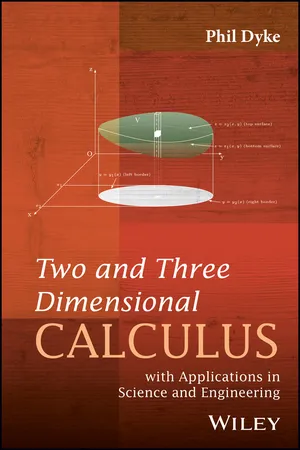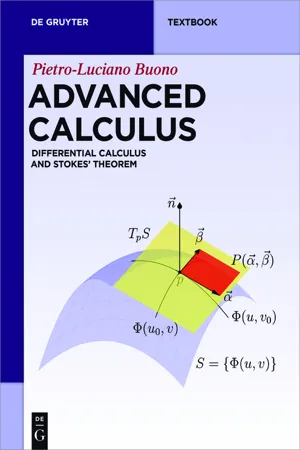Technology & Engineering
Double Integrals
Double integrals are a mathematical tool used to calculate the volume under a surface in two dimensions. They involve integrating a function over a region in the plane, and can be used to solve a variety of problems in fields such as physics, engineering, and economics. Double integrals are an important concept in calculus and are often used in computer simulations and modeling.
Written by Perlego with AI-assistance
Related key terms
4 Key excerpts on "Double Integrals"
- eBook - ePub
Two and Three Dimensional Calculus
with Applications in Science and Engineering
- Phil Dyke(Author)
- 2018(Publication Date)
- Wiley(Publisher)
Chapter 9 Multiple Integrals 9.1 Introduction Integration, as introduced previously, is the inverse of differentiation. Usually, the integral is interpreted as the area under a curve. For example, is the area under the curve between the values and. This works well provided in the range. In the last chapter, the path or line integral was introduced. Although the integration of this chapter is still the inverse of differentiation, it is not restricted to either finding areas under curves or indeed path integrals. As a starting point, it is best to think of a pixel on a screen moving first one way to describe a line, then the line moving at right angles to encompass an area. This way a domain is covered, and the magnitude of areas are calculated. Move in three perpendicular directions and volumes can also be calculated. Importantly, so much more than areas and volumes can be found in this way. For those more interested in mechanics, quantities such as the centre of mass and the moment of inertia can be found. For the statistically inclined, there are probability distributions defined over an area that occur in experimental design, for example. It is also possible to use co-ordinate systems other than Cartesian: plane polars in two dimensions and cylindrical and spherical polars in three dimensions. Given the new material, even though vectors could be involved here, a decision has been made to keep this chapter clear of vectors. We start with Double Integrals. 9.2 The Double Integral Figure 9.1 shows a typical region in the plane. The small black rectangular area is shown and the idea is that the expression should be uniquely defined. First of all, the integrand is an integrable function of both and. Functions that are piecewise continuous throughout and on the domain will suffice. The limits are defined to indicate the domain. Take a look at Figure 9.1. The small black rectangle has sides and - eBook - ePub
- Pietro-Luciano Buono(Author)
- 2016(Publication Date)
- De Gruyter(Publisher)
As mentioned above, we also need a more effective way of computing the double integral than using the definition. We know from elementary calculus that for simple integrals of functions of one variable, the Fundamental Theorem of Calculus enables one to relate the value of the integral to the existence of an antiderivative, or indefinite integral. There is no such result for Double Integrals. However, it is possible to decompose the double integral into a succession of two simple integrals as the next result shows.Theorem 7.2.4 (Fubini). If f is integrable on the rectangle ℝ. ThenThe idea of this theorem is that one can decompose the rectangle [a 0 , a 1 ] × [b 0 , b 1 ] using slices parallel to one of the axes. This is done as follows, say for slices parallel to the y -axis. Fix a value x ∈ [a 0 , a 1 ] and consider f (x, y ) with y ∈ [b 0 , b 1 ]. Then, we can compute the integral of the slice obtained using f (x, y ):Now, (7.2) depends on the value of x chosen to obtain the slice and so the resultFig. 7.6. Slice at x = x 0 of the domain.of (7.2) is a function of x . We writeThus, for every x ∈ [a 0 , a 1 ], G (x ) is the integral of a slice. Fubini’s theorem tells us that summing up all the integrals G (x ) for x ∈ [a 0 , a 1 ] corresponds to the integral of f (x, y ) over R .Example 7.2.5. Let ℝ = [0, 3] × [−1, 1] and f (x, y ) =ex+y . We computeComputation of mass and populations
The double integral can be used to compute physical quantities such as total mass or total electric charge if the mass or charge density is known. Suppose that a rectangular plate R of a certain material has density (with units of mass/unit area, say kg/m 2 ) given by a continuous function ρ (x, y - eBook - ePub
- Alan Jeffrey(Author)
- 2004(Publication Date)
- Chapman and Hall/CRC(Publisher)
9Double Integrals in Cartesian and plane polar coordinates
9.1 Double Integrals in Cartesian coordinates
Double Integrals arise in connection with many practical problems, one of the simplest of which is the determination of the volume between a plane area S in the (x , y )-plane and a surface z = f (x, y ) lying directly above it. Others involve finding the mass and moment of inertia of a variable density plane lamina, finding the amount of heat flowing through a plane area S in a unit time (the heat flux through S ), and the analogous problem of finding the amount of fluid flowing through a plane area S in a unit time when the speed of flow normal to S at each point of S is a function of position in S (the flux of fluid through S ).When introducing the ordinary definite integral in Chapter 7 , it was natural to start by using the convenient interpretation ofas the area between the curve y = f (x ), the x -axis and the two ordinates x = a and x = b. A corresponding geometrical analogy can be used when introducing the double integral written∫ a bf( x )d x(9.1)∫or sometimesd A ,∫ Sf(x , y)∫ Sf(d A ,x , y)where the integrand f (x , y ) is a continuous function of the two variables x and y, S is a plane area in the (x , y )-plane over which the integration is to be extended, and dA is the differential element of area in S.Let us begin by interpreting a double integral as a volume in order to give one possible physical interpretation of Eqn (9.1) . We will consider a volume to be an essentially non-negative quantity, so when determining the volume between the part of the surface z = f (x , y ) vertically above an area S in the (x , y )-plane it is necessary to confine attention to surfaces for which f (x , y )≥ 0, because if f (x , y )<0 volumes will be negative. Consider Fig. 9.1(a) showing a surface z = f (x , y ) lying vertically above a plane area S in the (x , y )-plane bounded by a closed curve Γ in the form of a single loop. Then the volume ΔVijof the small prism-like volume above the rectangle xi ≤x ≤xi+1 andyj≤ y ≤yj+1 containing an arbitrary point P in the (x , y )-plane with coordinates (ξi ,ηj - eBook - ePub
Elementary Calculus
An Infinitesimal Approach
- H. Jerome Keisler(Author)
- 2013(Publication Date)
- Dover Publications(Publisher)
12
MULTIPLE INTEGRALS
The first seven sections of this chapter develop the double and triple integral. They depend on Sections 11.1 and 11.2 on surfaces and continuous functions, but are independent of Chapter 10 on vectors.Sections 8 through 10 of this chapter discuss the relationship between multiple integrals, line integrals, and surface integrals. Chapters 10 on vectors and 11 on partial derivatives are prerequisites.12.1 Double Integrals
The double integral is the analogue of the single integral (definite integral) suggested by Figure 12.1.1 . Figure 12.1.1 (a) shows the area A bounded by the interval [a, b] and the curve y = f(x), and corresponds to the single integralFigure 12.1.1 (b) shows the volume V bounded by the plane region D and the surface z = f(x, y), and corresponds to the double integralOur development of Double Integrals will be similar to our development of single integrals in Chapter 4 . Before going into detail, we give a brief intuitive preview.Instead of closed intervals [u, v] in the line, we deal with closed regions D in the plane. A volume function for f(x, y) is a function B, which assigns a real number B(D) to each closed region D, and has the following two properties: Addition Property and Cylinder Property.Figure 12.1.1ADDITION PROPERTY
If D is divided into two regions D1 and D2 which meet only on a common boundary curve, then(Intuitively, the volume over D is the sum of the volumes over D1 and D2 .) This property is illustrated in Figure 12.1.2 (a).CYLINDER PROPERTY
Let m and M be the minimum and maximum values of f(x, y) on D and let A be the area of D. Then(Intuitively, the volume over D is between the volumes of the cylinders over D of height m and M. This corresponds to the Rectangle Property for single integrals.)This property is illustrated in Figure 12.1.2 (b).We shall see at the end of this section that the double integralis the unique volume function for a continuous function f(x, y
Learn about this page
Index pages curate the most relevant extracts from our library of academic textbooks. They’ve been created using an in-house natural language model (NLM), each adding context and meaning to key research topics.



